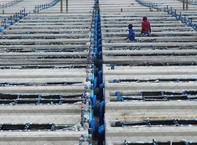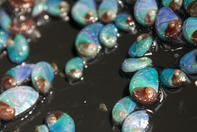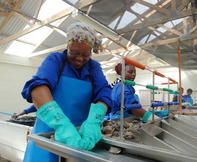Systems used in the farming of abalone are recirculating aquaculture systems (RAS), ranching, cage culture and flow-through systems.

The ‘Abalone Feasibility Study’ by Urban-Eco was prepared for the Departement of Agriculture, Forestry and Fisheries (DAFF) in 2018.
This study shows cage culture and ranching to be the most profitable systems, but in South Africa, land-based flow-through systems are used. In these systems, abalone is suspended in baskets in special tanks and fed a specially-formulated diet of artificial abalone feed often combined with fresh seaweed or kelp while seawater is continuously circulated through the system.
In the wild, male and female abalone both release their reproductive cells into the water through small openings. These reproductive cells then connect and fertilisation occurs.
About a day after fertilisation, abalone larvae will hatch and will float in the water for one to two weeks until a good substrate has been found to attach to. The larvae are now called ‘spat’. Over time it will develop a shell and grow by eating micro-organisms, algae and kelp.
Hatchery Phase

In farmed abalone, the hatchery process has four stages; broodstock, larvae, settlement and weaning. The hatchery period from egg to 10-millimetre spat takes six months. Only superior abalone - both wild and bred - are selected for spawning and kept in highly controlled environments. Abalone farm permits limit the number of wild broodstock that is allowed to kept to 200.
After fertilisation, free-swimming larvae hatch within hours and develop until ready to be transferred to a medium where they will attach and develop into baby abalone called ‘spat’.
As spat mature, their nutritional requirements change from a natural diet of micro-algae to Abfeed, a formulated abalone diet. When they reach the size of 10 mm spat are strong enough to be transferred to the grow-out environment. Some abalone farms may only transfer spat to the grow-out area when they are 20 mm in size.
Grow-out Phase
Abalone is kept in oyster net baskets suspended in tanks, through which seawater is circulated and fed an artificial diet, which is specially formulated for the species. Abalone diet is often supplemented with fresh seaweed or kelp.
Abalone tanks are cleaned weekly.
The optimal temperature range for abalone is between 16°C and 18°C. Lower temperatures may slow down growth, while higher temperatures may hinder larval development. Water is regularly tested and monitored for temperature, pH, oxygen and ammonia levels.
Throughout the grow-out phase, abalone is regularly sampled to check on their weight and then size graded, thinned out and moved, to improve stocking density. This allows for even and consistent growth. Stocking density may depend on tank size and management practices.
Typical survival rates for abalone are 86% over 45 months in recirculating cage (or flow-through) systems and 30% (after seeding) in a ranching system.
Depending on the farm's growth rates, animals may reach market size between 36 – 50 months.
Harvesting Abalone

Abalone is harvested according to the size needed for a specific order. Agents or customers can order very specific sizes such as 250 kg of 70 - 90 g and 100 kg of 150 - 160 g. The requested size usually has something to do with a dish the restaurant is preparing or portion size per person. Abalone is graded to ensure the right sized animals fulfil the order.
These animals are then conditioned by placing them in very clean filtered seawater for a few days. This helps them recover from the stress of the grading and helps them survive the airfreight to the Asian markets.
By Marinda Louw